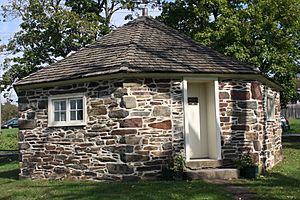Subscription school facts for kids
A subscription school was a special kind of private school that existed a long time ago, mostly in the 1800s. These schools were found in country areas of the United States and parts of the United Kingdom. They were common before public schools, called common schools, became widespread.
Contents
How Subscription Schools Worked
The way parents paid for subscription schools was different from other schools. Instead of paying a set fee for the whole year, they paid "by the scholar." This meant they only paid for the days their child actually went to school.
Paying for School Days
This payment method was very helpful for families living in the countryside. Children often had to help with farm work for many months of the year. Because parents only paid for attendance, they didn't have to pay when their kids were busy working on the farm. For this reason, subscription schools were often open only during the winter months.
Simple School Setup
Subscription schools were usually simple places. They were often just one room with a single teacher. These schools were not controlled by any big organization. This meant there were no set rules for what teachers needed to know or what subjects they had to teach. The education usually focused on basic primary grades.
Starting a New School
Before a subscription school could open, people would check the local area. They wanted to see if enough parents were willing to pay for their children to attend. If enough families agreed, the school could then be started.
Challenges and Changes
Subscription schools faced some challenges. They also played a role in how education changed over time.
Impact on Fairness
Since only parents who could afford to pay sent their children, these schools sometimes made things less fair. Children from poorer families often didn't get any education at all. This could lead to more illiteracy in rural areas.
Moving to Public Schools
Later, public schools started to replace subscription schools. This change sometimes caused big arguments. People in local communities often liked having control over their own schools. Moving to public schools meant losing some of that local control.
Other School Options
Subscription schools also had competition from other types of schools. In some areas, elementary parts of seminaries and academies also offered education. These schools often taught subjects up to or even beyond the secondary level.
Education for All
In some places, regular schools only allowed white students. In these areas, the subscription school model was often used by African American or Native American teachers and students.
Early Examples
For example, the first known African-American school in St. Louis, Missouri, was a subscription school. Hiram Revels, who later became a senator, started it in 1856. In North Carolina, the first school for the Lumbee tribe was a subscription school. It opened in 1870.
After the Civil War
After the Civil War, subscription schools for African Americans became very common in the American South. In Jefferson City, Missouri, Black veterans of the Civil War started the Lincoln Institute as a subscription school in 1866. These schools for Black students continued for a long time, even after the Reconstruction era ended.
Into the 20th Century
In some parts of the United States, like Oklahoma, new subscription schools were still being started even in the early 1900s.


